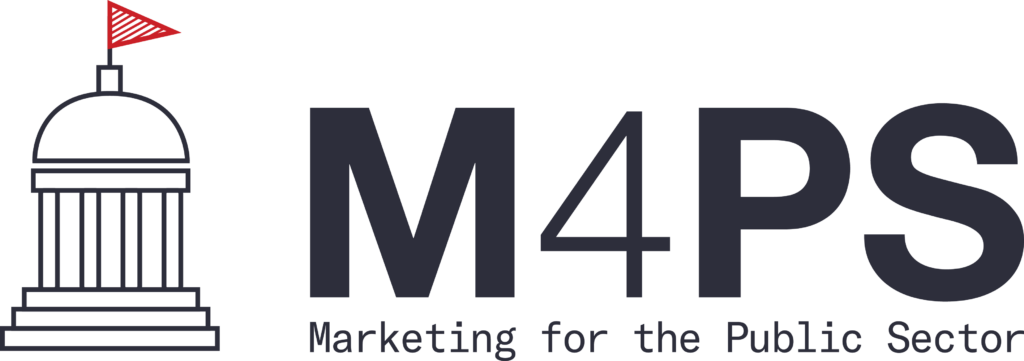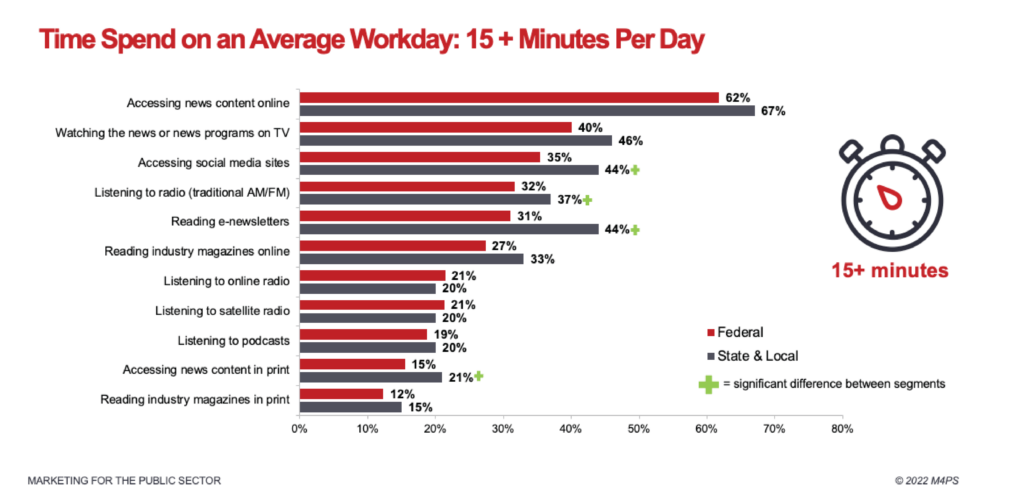public sector marketing
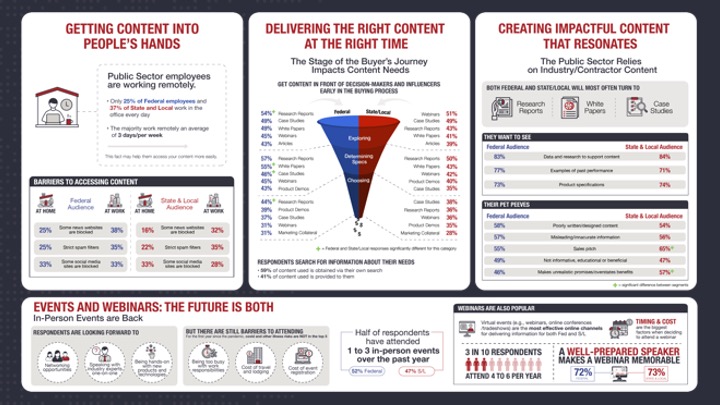
B2G marketers: this article is part 4 of a 4-part series recapping the June 2023 Content Marketing Review.
B2G Marketing on a budget… we’ve all been there. Most of us live there permanently. At the Content Marketing Review, Susan Rose, Senior Director of Insights and Content, GovExec and Monica Mayk, Head of Marketing, U.S. Public Services, Tata Consultancy Services talked about marketing on a budget. Part 1 of this series answered the question, “If it was a perfect world and you had everything that you wanted, what would your marketing strategy look like?”
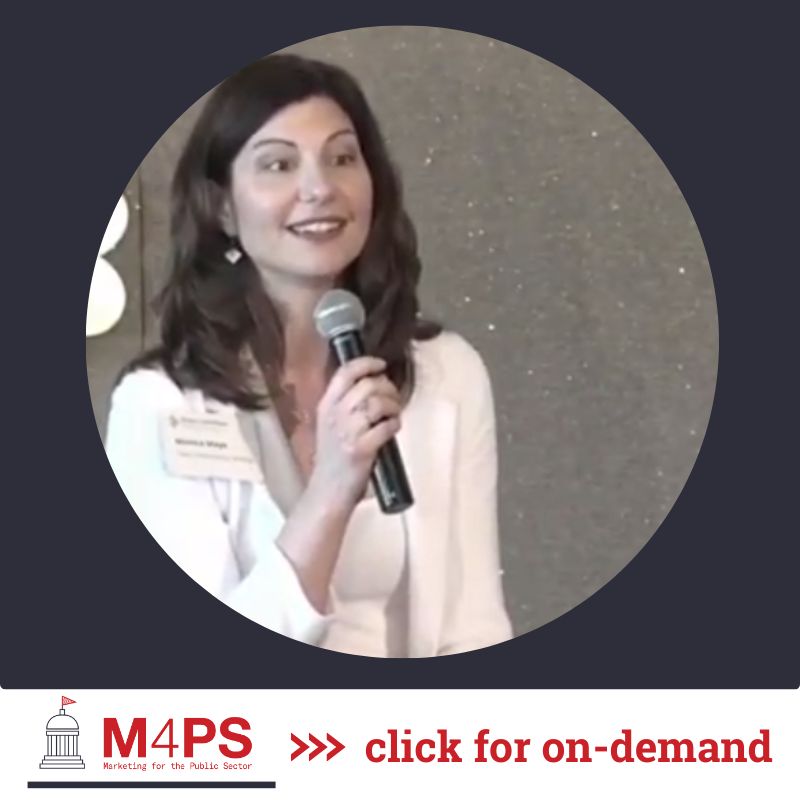 This panel answered: “Okay, we don’t have unlimited time, staffing or budget. How do we make all of this work?”
This panel answered: “Okay, we don’t have unlimited time, staffing or budget. How do we make all of this work?”
Investing More Money Into Marketing
A lot of people are wondering, “How can I implement a strategy when I have a micro budget? How do I work with a budget that’s tactical and get the results in return that superiors are wanting?”
Tight budgets are real. Yet senior leadership needs to understand that if they are not making a sufficient investment in marketing, the marketing units can’t be strategic or deliver the type of results they are looking for.
It is key for companies to set aside a certain amount of money for marketing so marketers can establish a reliable strategy that will result in their connected presence in the market. For example, when Monica worked with Verizon, she was on a shoestring budget. She only had a few hundred thousand dollars to support a two billion dollar business that was trying to sell into every federal agency. A few hundred thousand dollars wasn’t nearly enough to manage the vastness of the business, so she had to use that investment in creative ways to incur a reasonable outcome (listen to the on-demand recording to learn what she did).
Knowing the Portfolio is Key to B2G Marketing on a Budget
Knowing everything your company is selling under your portfolio is important in establishing a logical strategy. Referring back to Monica’s Verizon example, she had a gigantic portfolio and had little idea about some of the products and services that her company was selling. And she had to market solutions that people did not associate with the company’s brand. In fact, she almost had to work against the corporate and consumer brand by focusing solely on her priority, which at the time happened to be all of the federal agencies.
She established a process where she said, “let’s find the intersection between what we have to offer, what’s important to our customers, and who are the places we are selling to” so her company could establish some thought leadership and demonstrate some expertise. Through this process, she was able to narrow down the portfolio and pick a few key solutions that would connect to their customers and prospects. Security, connectivity and public safety were those initial priorities at the time. This process allowed Verizon to showcase key solutions and products that supported those specific themes that resonated with the agencies. By following this process, Verizon went from having no impact on the agencies to making their presence abundantly clear in the market.
Marketing Strategies
Conducting research and leveraging credible data that has been validated will always increase the trust the market has in you. Thought leadership and content campaigns, as well as advertising and awareness aspects, all aid in getting your message out there. A few B2G marketing methods that tend to be successful when you’re on a budget are:
- Articles
- White Papers
- Research Reports
- Advertising Messaging
Finding the right partner that will help you create, publish, promote, extend, and reuse content will end up being a high-value investment, because you are essentially receiving five things for the price of one. It is not only important to broadcast your content on your own website and LinkedIn account, but third party websites as well. Posting content on other sites increases your chance of reaching a larger audience.
Final Thoughts
It is important to note that marketing results will be measured over time. You cannot expect to garner results right away. That is one of the hardest things that finance teams cannot understand in the public sector. You have to wait three-to-five years before you start seeing practical results. As a prime example, Monica spent around a million dollars in marketing with Verizon over the course of three years on a single opportunity with one agency. After a five-year pursuit, Verizon won an agency single source contract for $2.3 billion dollars. A million dollar investment ended up turning into a $2.3 billion dollar, ten-year contract. This is just one of the many examples that proves if you invest a considerable amount toward your marketing budget then you can end up with an astonishing end result.
Get the Study
Want more? The Content Marketing Review is now available on demand. Click this link to learn more.
Related Posts
Marketing 4 the Public Sector (M4PS) Study Recap
Marketing The Funnel and Delivering the Right Content at the Right Time
Creating Impactful B2G Content
Events and Webinars: where we are, where we’re going
Federal SLED and Marketing on a Budget
Federal & State and Local Government Respondents Looking Forward to Networking Opportunities, Speaking with Industry Experts One-on-One, Being Hands-On with New Products and Technologies
Washington, DC / Monday, May, 22, 2023 — The research team at Market Connections Inc is releasing part two their Marketing for the Public Sector study at an exclusive information session happening in Tysons Corner, Virginia.
Industry experts will join President of Research and Forecasting at GovExec, Aaron Heffron, to present findings from the spring iteration of the Marketing 4 the Public Sector Study (M4PS): Content Marketing. Attendees will include marketing and communications leaders within the U.S. public sector. The exclusive information session and breakfast networking event is happening in Tysons, VA on Thursday, June 29th, at the Archer hotel.
Formerly the Content Marketing Review, the spring M4PS study answers pertinent questions about when, where, and how the public sector prefers to receive information about products and services. This information is critical in helping marketing and communications professionals develop actionable content marketing strategies.
Highlights from the study include:
- One third of respondents use LinkedIn for news related to their job vertical.
- The favorite format for job-related information and education is explainer videos.
- Respondents look to different types of content depending on where they are in the buying process.
- Respondents favor in-person events over virtual.
“In person events are back. While it’s still important to offer hybrid options, people are eager to get out and meet peers and vendors face-to-face,” said Heffron. “It is also important to note that the public sector turns to different content types depending on where they are in the buying process. That underlies the importance of creating a marketing strategy that hits each touchpoint.”
Regardless of company size or marketing budget, attendees of the M4PS breakfast can expect to leave the information session with pertinent, actionable information to inform marketing plans and strategies.
Early bird pricing ends June 12, 2023. Only a limited number of tickets are available, so register now to reserve your spot.
About Market Connections
Market Connections; a portfolio platform of GovExec, delivers trusted, actionable intelligence and insights that enable improved business performance and positioning for leading businesses, government agencies and trade associations. The custom market research firm is a sought-after authority on preferences, perceptions and trends among government executives and the contractors who serve them, offering deep domain expertise in information technology and telecommunications; healthcare; and education. Market Connections also provides the tools for organizations to expand thought-leadership in their respective markets and is known for its annual Marketing 4 the Public Sector study, the only comprehensive survey of the media habits of federal and state/local decision-makers, as well as the Federal IT (FIT) Personas Study. For more information, please visit: www.marketconnectionsinc.com.
When it comes to reaching public sector audiences there are a number of things to try, a number of avenues to venture down, and a number of platforms to spread your message on. If you’re reading this, you’re already aware of that.
Yet, with the plethora of information sources at our fingertips, it can be hard to narrow down the specific data needed to begin formulating marketing plans and strategies. That is why the Market Connections research team created a study specifically for the individuals and teams Marketing for the Public Sector (M4PS).
Part one of the study launched in October 2022 and provides insight into media engagement habits. Part two, slated to launch in June 2023, will get more specific, diving into the procurement and buying processes, current outlook regarding participation in in-person/virtual events, as well as media/content format preferences.
Overview
We surveyed more than 1,000 people working in the federal and state/local government about their media engagement habits. We asked them about:
- Top concerns for the next year
- How much trust do they have in the information they get from certain sources
- How much time is spent on an average workday accessing certain media
- Top digital sites for getting news/information
- Confidence in news sources
- Social media usage
- Top sites for streaming
- Data/information on podcast listenership
Included are key insights, observations and takeaways from analysts – as well as specific data on the DMV market (D.C. Maryland, and Virginia region.) Whether you are interested in a broad awareness campaign, or a more focused agency-based marketing effort, our aim with part one of the M4PS report is to provide you with trusted data, ultimately serving as launching point for your future planning endeavors.
What is important to your audience
Figuring out what’s important to your audiences is key. It allows you to make decisions with a wider lens or narrow down and go niche if necessary.
By arming yourself with both parts of this report you will be able to further strategically position yourself exactly where you want to be in the public sector market. Since all goals are different and there is no one-size-fits-all approach to planning, we started here by anticipating your needs, so you can in turn begin to anticipate the needs of your audiences.
The media engagement report is available now.
And keep an eye and ear out for M4PS part two, coming in June 2023.
Have questions? Want more information? Please reach out to info@marketconnectionsinc.com.
2022 Update
STAY CONSISTENT TO REACH TARGET AUDIENCES
In the last few years the way we seek and receive news has been changing and evolving faster than ever. Between the COVID-19 pandemic more or less forcing many companies to adapt to work from home trends, team collaboration needs, and an industry wide push toward cloud, things are getting more digital by the day.
While many people still start mornings off with a newspaper, listening to the radio on the commute to work, or gathering around the TV for the evening news, they don’t confine news consumption to those times. Increasingly, most likely due to the ubiquity of remote work and the convenience of cell phones and apps, people are engaging with news outlets and seeking out important updates from various digital sources throughout the day, a trend public sector marketers can (and should) take advantage of.
LEARN MORE MEDIA TRENDS
Part 1 of the 2-part 2022 Marketing for the Public Sector (M4PS) study looks at media engagement among both federal and state/local audiences.
Brought to you in a neatly packaged two part study, M4PS, called “maps” for short, focuses on the digital world around us. A first look at highlights from the M4PS study were presented to attendees at Government Marketing University’s GAIN conference, and part one of the full report will be available to purchase in November.
STAY UP ON TRENDS AND BE WILLING TO ADJUST ACCORDINGLY
Market Connections will continue to look at trends and impacts on federal and state and local employees’ media usage and preferences. Learning where your potential customers go for news and information can be fabulously useful in building a marketing plan. A better understanding of demographics, “go-to” news sources and most trusted social media channels can help you consistently put your message where their mind is.
Federal and state/local customers, just like the rest of us, are affected by outside factors. Marketers can’t always rely on by-the-book and tried-and-true methods of the past. A willingness to stay on top of current trends and adjusting current strategies based on new information is a must.
Need data to help make informed purchasing decisions? Our M4PS study provides the information you need.
Need more custom research to learn about your customer’s needs, challenges, perceptions and preferences? Reach out today. We’d love to help!
Over the past couple of weeks, we’ve shared how to take advantage of increased screen time among government audiences, as well as, how to effectively pivot your in-person meetings to virtual ones. Now we take a look at the pervasive online vehicle that only continues to grow in influence: social media. In addition to your own website and public sector media channels, social media is essential to reaching your target audiences.
According to our latest Federal Media & Marketing Study (FMMS), on average, nearly one-third of federal employees are spending 15 minutes or more on social media. It’s no surprise the top two social sites among feds are Facebook and LinkedIn with 4 out of 10 alone visiting Facebook daily. As government employees are tethered more to their computer, we expect these numbers to climb and the lines of personal and professional social media usage to blur even further.
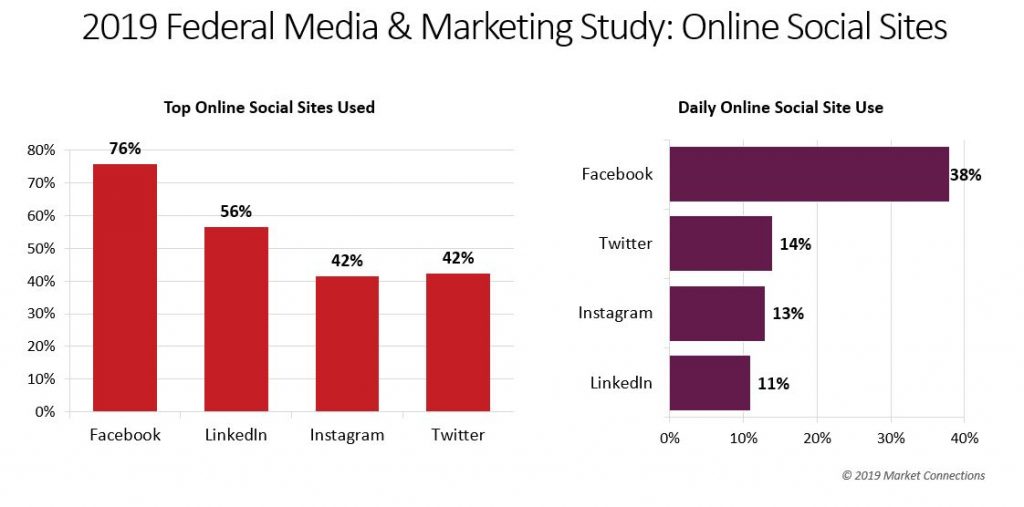
The old adage of not being able to reach the public sector through social media no longer holds water. Whether it’s via professional social media channels (approximately 2.1 million federal employees are on LinkedIn), or the increased ability to view social media on personal devices, social media marketing should be a key part of your overall marketing mix.
Our Content Marketing Review highlights that the professional value of social media goes beyond just traditional awareness building. Nearly half of federal decision-makers and 7 out of 10 state and local decision-makers found professionally based LinkedIn and LinkedIn communities useful portals for accessing content for educational purposes. The efficacy of social media to deliver content even bled over to the traditionally personal social realm. One-quarter of federal and over half of state and local decision-makers felt Facebook and Twitter were also useful sources for work-related content.
Using social media can help you not only place you in front of your audiences, but also drive traffic to the content you’ve placed on other channels to help increase visibility and lead generation. It also allows others to help you drive traffic by making it shareable.
Learn more:
- How effective are social media sites? Download the Content Marketing Review
- What social media sites do they visit? Purchase the Federal Media & Marketing Study Overview and Audience-Based Reports
- Watch the complimentary webinar: How Are Federal Employees Using Social Media in the Workplace
How can we help?
- Contact: Aaron Heffron (aaronh@marketconnectionsinc.com) to discuss social media strategies and content generation
Our last blog post “Increased Screen Time Equals More Time with Public Sector Decision-Makers” focused on taking advantage of increased screen time by providing your government customer with content that educates and informs. The next step is to place your content where your customer is already going.
Before placing content on other media channels, take stock of your own corporate site. Approximately 7 out of 10 public sector decision-makers believe that corporate websites are an effective online source for information. If your customer were to visit your corporate site, or preferably a federally focused microsite, is the content they are looking for available and easily accessible? Is your site easily navigable? How far would your customers have to dig to find information around resources they are looking for? Is your site and its contents search engine optimized?
What Online Channels Do They Go to for Content?
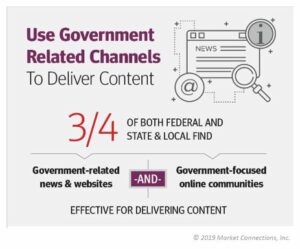
From 2019 Content Marketing Review
According to our recent Content Marketing Review, three-quarters of both federal and state and local decision-makers find government-focused online communities and government-related news websites (e.g., GovLoop, Governing, Government Executive or Federal News Network) effective for delivering content to educate and inform their work-related buying process.
We are also hearing from top government-focused publications that increased screen time has driven up the number of visitors to their sites and subscriptions to their e-newsletters. With this in mind, sponsored content or advertising across highly trafficked online sites should be part of your strategy, if budget allows. If it doesn’t allow right now, work with your subject matter experts and other thought leaders in your organization to develop content attractive to these publications. Earned media can often be more effective than paid media.
To make data-based decisions on where to focus your media purchasing budgets, consider sources like the Federal Media & Marketing Study (FMMS) that allow you to strategically match your company’s target audiences with the publications and sites they most frequent. Spending, matched with strategic market information, can maximize your impact.
Learn more about FMMS audience-based reports available for purchase
Now Is the Time to Educate Your Government Customer
In our last blog post, Webinars in Place of In-Person Events – A New Normal?, we shared insights about public sector webinar preferences to help marketers refocus their marketing dollars from live events and conferences to virtual events. However, webinars may only be the tip of the virtual iceberg.
With more public sector employees teleworking and with travel and in-person events on hold, marketers can expect a spike in online traffic. It’s time to use this increased screen time to be a partner to your customer. Digital platforms allow for greater, self-directed education opportunities on ways to address new, or redirected, agency priorities and missions. Being a source of high-quality information has always been one of the best ways to build a strong, long-term relationship with your customer.
What Is Needed to Deepen Your Relationship with Your Customer
Over the years, our surveys have consistently noted that white papers, research reports and case studies are among the type of content most valued by federal and state and local decision-makers. The best designed of these assets, typically, have one thing in common: they educate the customer without feeling salesy.
It’s not always easy to figure out what you should or should not include in these content pieces. Our Content Marketing Review revealed that public sector decision-makers want data and research to support the content, examples of past performance and product specifications. Fancy visual contents, insights from industry thought leaders and content tailored to their vertical were less critical to the success of good content.
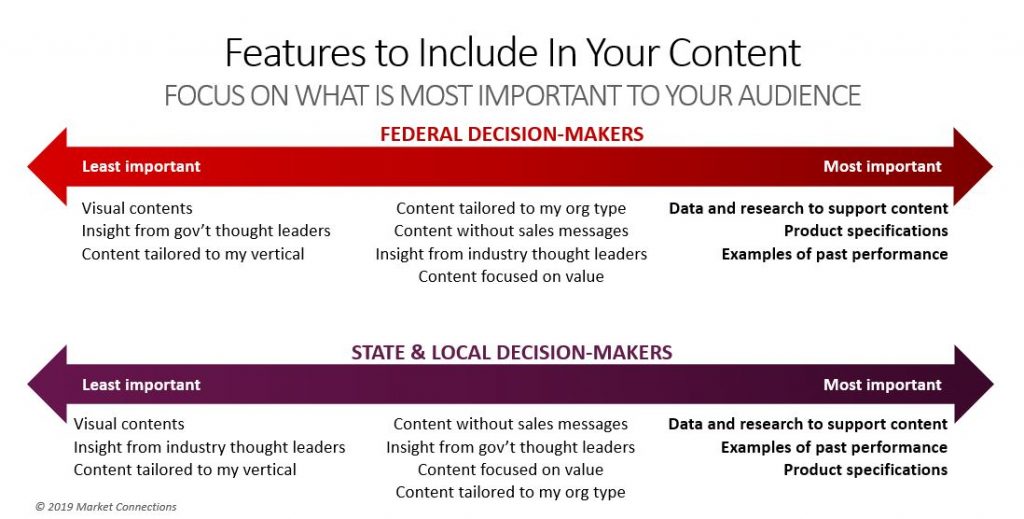 For detailed charts of top features across key marketing assets, download the presentation.
For detailed charts of top features across key marketing assets, download the presentation.
With the increased screen time your customers are experiencing, if you haven’t already, now might be a great time to create or update your marketing content to educate your customer while they have less “out of office” distractions and more screen time.
“Our company provides innovative, cutting-edge services meant to disrupt the existing paradigm through best-in class products, agile, game-changing industry leaders and a one-stop, value added portal.”
If “Buzzword Bingo” were a game, this sentence would have hit all the squares on the bingo card!
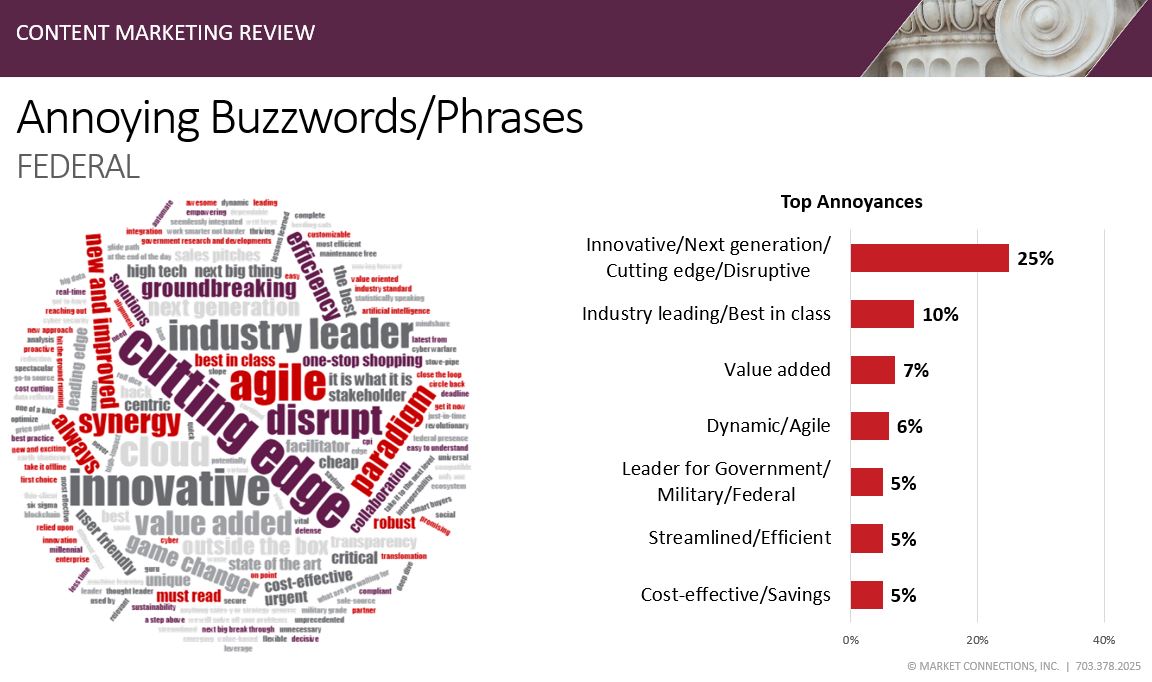
From the 2019 Content Marketing Review: Federal & Beyond
Writing a description of how your product, service or even your company, is different than your competitors can be difficult for B2G marketers. Commonly used words like innovative, cutting edge and next generation, have lost their impact and can ring hollow to customers. While marketers often get requests to use these words in their materials, can including these words in marketing content hurt a brand, rather than help it? According to the Market Connections’ 2019 Content Marketing Review: Federal & Beyond study, certain words and phrases may annoy readers more than they explain what you do. In addition, as we have shown in our recent webinar, Differentiation in a Federal Market: How Do You Stand Out?, leaning heavily into these phrases does not necessarily aid in the overall differentiation of your company in a crowded, evolving marketplace. Our in-house database of digital marketing collateral from 100 top technology contractors contains millions of words and highlights the similarities between what is being promised from vendor to vendor.
Content aimed towards government IT customers, whether a white paper, marketing collateral, or a white board-style video, should be built upon three pillars: data and research; product specifications; and past performance. While it may be difficult to avoid all buzzwords, your content should focus on including these three pillars to ensure you keep your customer engaged. Federal, state and local technology decision makers want direct and informative content without the jargon to avoid the overt feeling they are being sold a bill of goods.
Finally, make sure your content includes clear statements focused on the value of your product or service to the organization, in non-technical terms customers can circulate. Three-quarters of federal respondents and over half of state and local respondents admitted to sharing content electronically with colleagues, teams and supervisors, many of whom may not have the same technical expertise as your initial target and may be even less tolerant of buzzwords.
Throughout our review of feedback from federal, state and local IT decision makers, we consistently came back to the theme that content should educate. Education is about presenting the right information at the right time using language that can be understood by the audience. By ensuring that you are meeting the expectations and needs of your audience and avoiding buzzwords and phrases, you are one step closer to creating content that meets your prospect’s needs, and, in turn, advances your company throughout the sales process.
To get the full list of top “annoying buzzwords” for both federal and state and local audiences, contact us at mcanizales@govexec.com.
Learn more about content preferences of federal, state and local IT decision makers by downloading the full report and infographics of the 2019 Content Marketing Review: Federal & Beyond.
Watch the recording and download slides for our webinar: Differentiation in a Federal Market: How Do You Stand Out?

